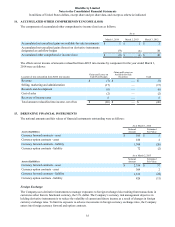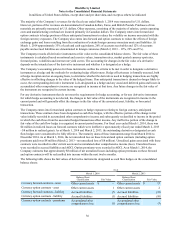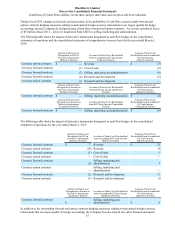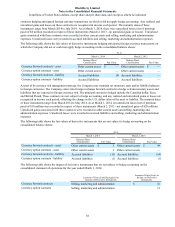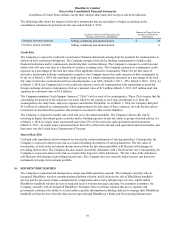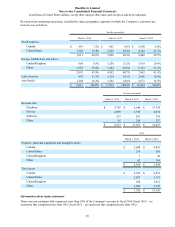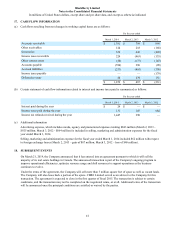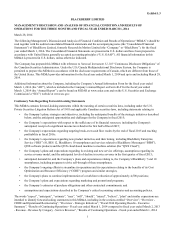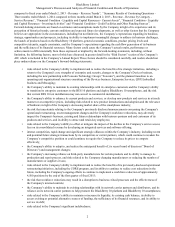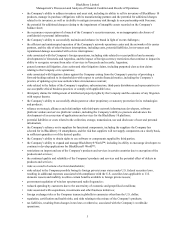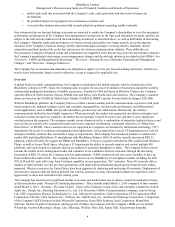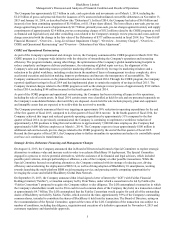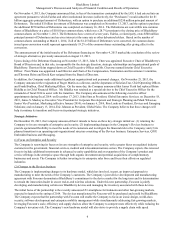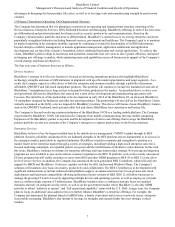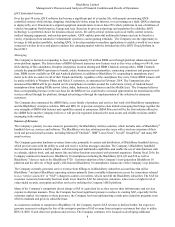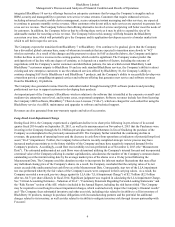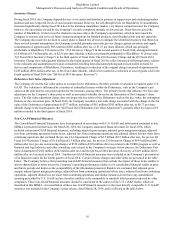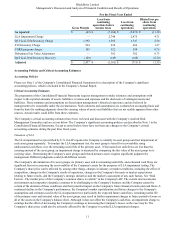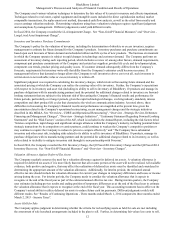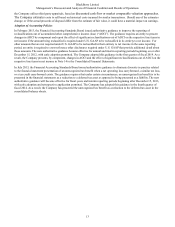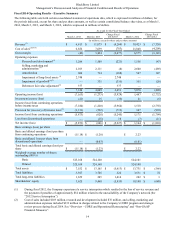Blackberry 2014 Annual Report Download - page 134
Download and view the complete annual report
Please find page 134 of the 2014 Blackberry annual report below. You can navigate through the pages in the report by either clicking on the pages listed below, or by using the keyword search tool below to find specific information within the annual report.BlackBerry Limited
Management’s Discussion and Analysis of Financial Condition and Results of Operations
4
• market and credit risk associated with the Company’s cash, cash equivalents and short-term or long-term
investments;
• the potential impact of copyright levies in numerous countries; and
• costs and other burdens associated with recently adopted regulations regarding conflict minerals.
Any statements that are forward-looking statements are intended to enable the Company’s shareholders to view the anticipated
performance and prospects of the Company from management’s perspective at the time such statements are made, and they are
subject to the risks that are inherent in all forward-looking statements, as described above, as well as difficulties in forecasting
the Company’s financial results and performance for future periods, particularly over longer periods, given the ongoing
transition in the Company's business strategy and the rapid technological changes, evolving industry standards, intense
competition and short product life cycles that characterize the wireless communications industry. These difficulties in
forecasting the Company's financial results and performance are magnified at the present time given the uncertainties related to
the Company's operational restructuring, recent management changes and the strategic initiatives described in this MD&A. See
“Overview - CORE and Operational Restructuring”, “Overview - Strategic Review, Debenture Financing and Management
Changes”, and “Overview - Strategic Initiatives”.
The Company has no intention and undertakes no obligation to update or revise any forward-looking statements, whether as a
result of new information, future events or otherwise, except as required by applicable law.
Overview
A global leader in mobile communications, the Company revolutionized the mobile industry with the introduction of the
BlackBerry solution in 1999. Today, the Company aims to inspire the success of its millions of customers around the world by
continuously pushing the boundaries of mobile experiences. Founded in 1984 and based in Waterloo, Ontario, the Company
operates offices in North America, Europe, Middle East and Africa, Asia Pacific and Latin America. The Company’s common
shares are listed on the NASDAQ Global Select Market (NASDAQ: BBRY) and the Toronto Stock Exchange (TSX: BB).
With the BlackBerry platform, the Company believes it offers a market-leading mobile communications experience with push-
based connectivity, industry-leading security and enterprise manageability, excellent radio performance and differentiated
social applications, such as BBM, that provide immediacy, productivity and collaboration. Historically, the wireless
communications market has been highly segmented. Where previously the market was segmented into distinct enterprise and
consumer/extreme productivity segments, the market has increasingly evolved in recent years and there is now significant
overlap between the segments. The enterprise market is now characterized by a combination of enterprise-deployed devices and
devices that are purchased by consumers but also used in the corporate environment, commonly referred to as “Bring Your
Own Device” or BYOD. These consumer devices are supported in a corporate environment by information technology (“IT”)
departments for access to corporate messaging and data applications. As the market has evolved, IT departments now look for
enterprise mobility solutions that can handle a range of requirements. The Company has introduced products to address this
market shift including BlackBerry 10 smartphones with BlackBerry Balance, BES 10 and the recently announced BES 12
platform, which will unify the support for BBOS and BlackBerry 10 devices, together with that for iOS, Android and Windows
Phone, as well as Secure Work Space, which give IT departments the ability to securely monitor and control multiple OS
platforms, and securely protect corporate data on an employee’s personal smartphone or tablet. The Company believes that it
remains the mobile device management leader and continues to see confidence from its customers through the increasing
penetration in BES 10, where the Company now has approximately 33,000 commercial and test servers installed to date, up
from 30,000 in December 2013. The Company’s latest devices are its BlackBerry 10 smartphone models, including the Z30,
Z10, Q10 and Q5, each with Long Term Evolution capability on next generation, “4G” networks. These 4G networks offer a
number of improvements over the previous generations, with improved download and upload speeds being the most widely
promoted. Wireless carriers in the United States have been aggressively deploying and marketing 4G networks. Deployment of
4G networks remains relatively limited globally, but wireless operators in many international markets are expected to move
aggressively to these new networks in the coming years.
The Company has experienced a significant decline in revenue and market share due to intense competition and other factors,
as discussed below under “Results of Continuing Operations – Three months ended March 1, 2014 compared to three months
ended March 2, 2013 – Revenue – Revenue Trends”. Some of the Company’s main device and enterprise competitors include
Apple Inc., Google Inc., Samsung Electronics Co., Ltd., LG Electronics Mobile Communications Company, Lenovo Group
Ltd., HTC Corporation, Huawei Technologies Co., Ltd., Microsoft Corporation, Nokia Corporation, ZTE Corporation, IBM
Corporation, SAP AG, Citrix Systems, Inc., VMware, Inc., Mobile Iron, Inc., and Good Technology Corporation. Competitors
of the Company's QNX business include Microsoft Corporation, Green Hills Software, Intel Corporation, MontaVista
Software, Mentor Graphics Corporation, and Sysgo AG. Products that compete with the Company's BBM service include
WhatsApp, Facebook Messenger, Skype, Line, iMessage, WeChat, Viber, Kik, Kakao Talk, Telegram and Snapchat.


